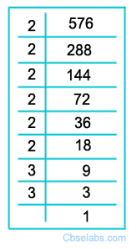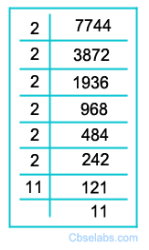Squares of all integers are known as perfect squares. In this lesson, we will discuss a very interesting Mathematical shortcut: How to check whether a number is a perfect square or not. There are some properties of perfect squares which can be used to test if a number is a perfect square or not. They can definitely say if it is not the square. (i.e. Converse is not necessarily true).
All perfect squares end in 1, 4, 5, 6, 9 or 00 (i.e. Even number of zeros). Therefore, a number that ends in 2, 3, 7 or 8 is not a perfect square.
For all the numbers ending in 1, 4, 5, 6, & 9 and for numbers ending in even zeros, then remove the zeros at the end of the number and apply following tests:
4539 ends in 9, digit sum is 3. Therefore, 4539 is not a perfect square
5776 ends in 6, digit sum is 7. Therefore, 5776 may be a perfect square
Step 1: A perfect square never ends in 2, 3, 7 or 8
This is the first observation you will make to check if the number is a perfect square or not. For example, consider the example 15623.
15623
By just noticing the number itself, we can conclude that 15623 cannot be a perfect square. We do not have to go to Step 2.
Step 2: Obtain the digital root of the number:
How does the digital root of a number would help in determining if a number is a perfect square or not. It turns out; a perfect square will always have a digital root of 0, 1, 4 or 7.
Take the number 15626 for example. This number ends in digits 6. So it satisfies Step 1. But still we cannot conclude, this number as a perfect square.
Let’s take the digital root of this number.
So, the digital root of this number is 2. A perfect square will never have a digital root 2. Hence, we can conclude 15626 is not a perfect square.
Now, there is a rider for this shortcut though, even if both Steps are satisfied, that does not guarantee that the number is a perfect square.
Let us take up an example here. Consider the number 623461, which is not a perfect square.
Notice that the unit digit is 1. This number could be a perfect square. Let us take the digital root.
The digital root of 623461 is 4. So it satisfies both Step 1 and 2. Still we cannot conclude that 623461 is a perfect square though.
However, this shortcut comes in really handy to eliminate obvious choices which are not a perfect square to solve competitive examination where you need to find the perfect squares.
Is 14798678562 a perfect square? Is 15763530163289 a perfect square?
Examine both the units digits and the digital roots of perfect squares to help determine whether or not a given number is a perfect square.
 As we know a perfect square can only end in a 0, 1, 4, 5, 6, or 9; this should allow us to determine whether the first of our numbers is a perfect square. However, it isn't sufficient to draw a conclusion about the second number.
As we know a perfect square can only end in a 0, 1, 4, 5, 6, or 9; this should allow us to determine whether the first of our numbers is a perfect square. However, it isn't sufficient to draw a conclusion about the second number.
Again as we know that if a perfect square ends in 9; it’s tens digit is always even. Alas, even if we do this, it won't rule out numbers ending in 89, because '...89' is a possible square.
However, as we know no number can be a perfect square unless its digital root is 1, 4, 7, or 9; so, find the digital root of our second number. It’s 5. As 5 isn't in this list, then the number is definitely not a perfect square.
So, we can conclude, a number cannot be an exact or perfect square if
- it ends in 2, 3,7 or 8
- it terminates in an odd number of zeros
- its last digit is 6 but its penultimate (tens) digit is even
- its last digit is not 6 but its penultimate (tens) digit is odd
- its last digit is 5 but its penultimate (tens) digit is other than 2
- its last 2 digits are not divisible by 4 if it is even number














0 comments:
Post a Comment